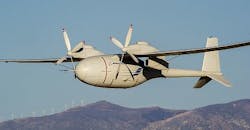Hydrogen-powered drone completes second test flight, lands well with redesigned landing gear
ST. LOUIS, 28 Feb. 2013. A hydrogen-powered unmanned drone built by the Boeing Co. Defense, Space & Security segment in St. Louis completed its second test flight this week during which the twin-engine propeller-driven unmanned aerial vehicle (UAV) demonstrated capabilities that will enable it to perform intelligence, surveillance and reconnaissance (ISR) missions for up to four days without refueling, Boeing officials say.
The flight, at NASA's Dryden Flight Research Center at Edwards Air Force Base, Calif., saw Phantom Eye climb higher than 8,000 feet and cruise for 66 minutes at 62 knots before landing. The aircraft exceeded what it achieved last year during its first flight when it flew at 4,080 feet for 28 minutes.
The Phantom Eye made its first test flight last June at NASA Dryden, and sustained damage when its landing gear dug into the landing strip on a dry lakebed and broke.
The long-range Phantom Eye UAV offers "on-demand, persistent ISR [intelligence, surveillance, and reconnaissance] and communications to any region in the world, rapidly responding to natural disasters and national security issues," says Darryl Davis, president of Boeing Phantom Works in St. Louis.
Boeing is self-funding development of the Phantom Eye, which generates only water as a byproduct of its propulsion system.
Following the first flight, Boeing upgraded the aircraft's software and hardware, including the landing gear. The Phantom Eye demonstrator can carry a 450-pound payload while operating for as long as four days at altitudes as high as 65,000 feet.
For more information contact Boeing Defense, Space & Security online at www.boeing.com/bds.

